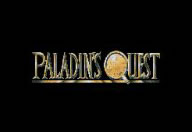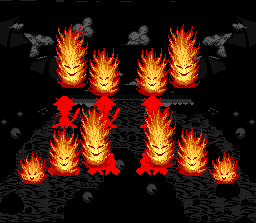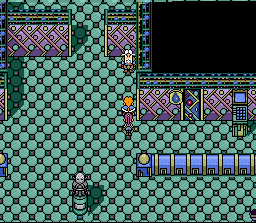|
|

|
PLATFORM
|
SNES
|
BATTLE SYSTEM
|

|
INTERACTION
|

|
ORIGINALITY
|

|
STORY
|

|
MUSIC & SOUND
|

|
VISUALS
|

|
CHALLENGE
|
Moderate
|
COMPLETION TIME
|
20-40 Hours
|
|
OVERALL

|
+ Large playable cast
+ Unique overworld look
- Bothersome interface
- Random turn nonsense is bad here
- Mercenaries cannot equip or learn anything new
|
Click here for scoring definitions
|
|
|
In the early days of the Super Nintendo, Enix localized several titles before closing its offices outside Japan for several years. Lennus was one of the lucky games to be localized, though Enix made the decision to retitle it Paladin's Quest. There are no paladins in the game, making the new name inexplicable. Paladin's Quest is a serviceable early Super Nintendo RPG that manages to infuriate on a consistent basis with its numerous issues.
Chezni is a magic student of Lennus when a friend dares him to go climbing the Forbidden Tower that is forbidden for a reason. Naturally, the reason turns out to be an Ancient Evil that promptly levels the magic school and prompts the school's director to send Chezni off to undo the mess he made. Very quickly Chezni will happen upon Midia, and the two of them will journey over the land of Lennus to find the means of defeating the Ancient Evil, along the way dealing with a power-hungry emperor and even undergoing time travel to observe the events leading to this state of affairs. The story is not terrible, but suffers from the usual ailments circa 1993: brevity and a thoroughly uninspired translation. It does have an incredibly hilarious moment when lava recedes from a city leaving the buildings and people untouched, however.
Wandering around the world of Lennus, Chezni and Midia will naturally have to fight. Enemies will randomly pop up to battle, and the turn-based battles that ensue look superficially similar to many other games with such a system. Paladin's Quest has a few quirks however, such as the use of the D-pad instead of buttons being the means by which battle strategies are arrived at. The player will press left, right, up or down to determine what spell or piece of equipment will be used. This is different enough from other games to deserve a mention. Also worth mentioning is how magic is cast by siphoning HP from the caster. Sadly the game never displays the HP cost of a spell, trusting in the player's memory to keep it straight. Experience and money are derived from victory in combat, with character statistics increasing once sufficient experience is acquired. New spells are not learned through this method, with Chezni and Midia being taught (at a price) new Spirits that increase their spell repertoire as the game progresses. These Spirit teachers are not mandatory but should be avidly sought out thanks to magic being more useful than physical attacks.
 Toasty!
Toasty!
|
|
There are several irritations present with this battle system, not including the aforementioned inability to gauge how much HP a spell costs. Turn order is afflicted with the random order many games features quite badly as the game progresses, to the point where a character that acted first in a prior battle will act after all of the enemies in the next one. Enemies cannot be targeted individually and instead must be targeted by groups - this is most aggravating when several enemies of the same type are inexplicably in different groups solely because the programmers were feeling vindictive. Enemies are also prone to multiple strikes when they use physical attacks, which is unfair when the player cannot do the same. The ability to strengthen magic by repeatedly using an element is nice but does not outweigh these irritations.
Coming from straight battle to interaction outside of battle, the glaring issues become quite vexing. The effects of equipment cannot be observed prior to purchase, and equipping any item is a labyrinthine process requiring that all six of the equipment slots (head, both arms, body, legs, and belt) be checked through one at a time with the effects of equipment requiring the player to display a good short term memory for statistic comparisons. The six character limit on item names will create confusion as the player tries to figure out precisely what they do. Upon usage of a healing item (and since only two spells heal, one by siphoning HP from enemies and one by sacrificing the caster to rejuvenate everyone else, items are mandatory for healing) the game exits from the menu, making the healing process lengthy and repetitive.
Chezni and Midia are the only characters whose magic repertoire can be increased and are also the only characters who can have their equipment altered. There are four combat slots in battle however, and the other two are filled by some story-provided characters and a lot of mercenaries. Mercenaries can be ignored if the player wishes, though they make the game much easier. Some of them require payment to participate in battle, some join out of good will (perhaps at embarrassment over their names - the great Mouth has a nasty connotation). Mercenaries and story-provided characters do have a semblance of personality and gain experience with Chezni and Midia, but they cannot learn additional magic and their equipment cannot be altered. This means the vast majority of mercenaries are made obsolete as the game progresses.
 Once the ancient neo-natal ward, something went horribly wrong with that pursuit.
Once the ancient neo-natal ward, something went horribly wrong with that pursuit.
|
|
The look of Paladin's Quest certainly differentiates it from other SNES titles, and almost seems inspired by Dr. Suess. The overworld in particular features strangely-shaped, strangely-colored plants that remind me of Seuss's works. Character portraits in the menus also remind me of his work, although their atrocious art design is a definite detriment. Aside from the unique colors and shapes on display, nothing here is impressive.
I want to like the music in Paladin's Quest more than I actually do, simply because Kouhei Tanaka is a great composer who wrote all the music for, among others, Sakura Taisen. Much of the composition here is certainly entertaining but the tracks are often rather short and the synth work unappealing to hear in places. The sound effects are alternately bizarre (lots of percussion effects in battle with cymbals being heard for actions completely unrelated to them) or unpleasant (the infernal noise accompanying every choice in the menus).
The game probably requires somewhere in the neighborhood of 20-30 hours to complete, and I took towards the longer end of that range. Incentives for replay are scarce; save for testing different mercenaries in combat or perhaps exploring a couple of dungeons that offer multiple paths, there is nothing additional to do. As for challenge, power-leveling will solve most problems here. Two particularly useful spells are MgWall and AtBack: these respectively reflect half the damage of magic and physical attacks back to their user, making bosses do an incredibly good job of beating themselves (and thanks to my own momentary lapse of judgement allowed the final boss to fall by that method).
Paladin's Quest is not an execrable RPG. It is not good either, and its many logistical logjams make playing a test of the player's patience often. Interesting ideas are displayed here and executed reasonably well, but that does not make up for the many afflictions described prior. This is a game only for those interested in hunting down every last scrap of SNES-era material with any interest, and it should not be accorded a high place on such a hypothetical person's list.
Review Archives
|









